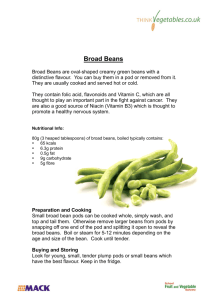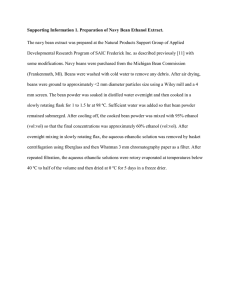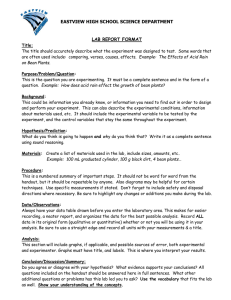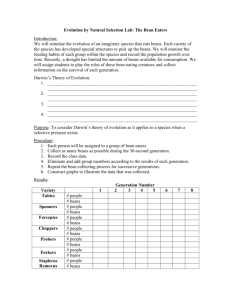Document 13800441
advertisement
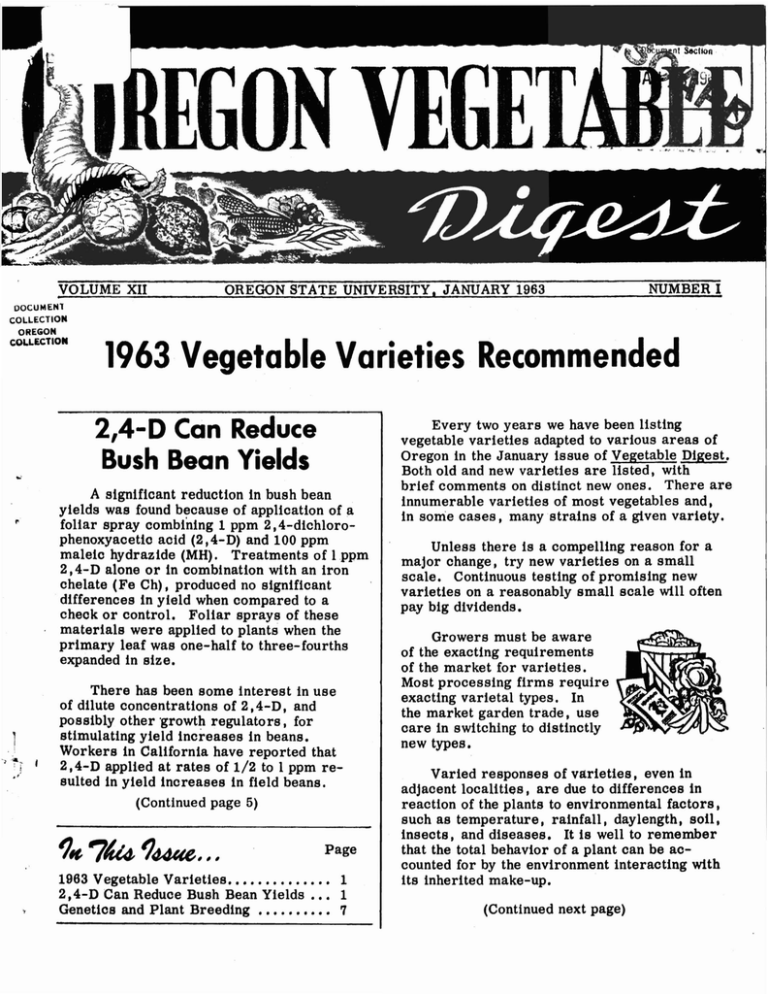
VOLUME XII DOCUMENl COLLECTION OREGON COLLECTION OREGON STATE UNIVERSITY. JANUARY 1963 1963 Vegetable Varieties Recommended 2,4-0 Can Reduce Bush Bean Yields ~. 1 " ~l ' .' NUMBER 1 A significant reduction in bush bean yields was found because of application of a foliar spray combining 1 ppm 2, 4-dichloro­ phenoxyacetic acid (2,4- D) and 100 ppm maleic hydrazide (MH). Treatments of I ppm 2,4-D alone or in combination with an iron chelate (Fe Ch), produced no significant differences in yield when compared to a check or control. Foliar sprays of these materials were applied to plants when the primary leaf was one-half to three- fourths expanded in size. There has been some interest in use of dilute concentrations of 2,4-D, and possibly other 'growth regulators, for stimulating yield increases in beans. Workers in California have reported that 2,4-D applied at rates of 1/2 to I ppm re­ sulted in yield increases in field beans. (Continued page 5) 11e 74u 144«e, ,, Page 1963 Vegetable Varieties •••••••••..••• 1 2,4-D Can Reduce Bush Bean Yields ••• 1 Genetics and Plant Breeding •••••••••• 7 Every two years we have been listing vegetable varieties adapted to various areas of Oregon in the January issue of Vegetable Digest. Both old and new varieties are listed, with brief comments on distinct new ones. There are innumerable varieties of most vegetables and, in sonie cases, many strains of a given variety. Unless there is a compelling reason for a major change, try new varieties on a small scale. Continuous testing of promising new varieties on a reasonably small scale will often pay big dividends. Growers must be aware of the exacting requirements of the market for varieties. Most processing firms require exacting varietal types. In the market garden trade, use oare in switching to distinctly new types. Varied responses of varieties, even in adjacent localities, are due to differences in reaction of the plants to environmental factors, such as temperature, rainfall, daylength, so11, insects, and diseases. It is well to remember that the total behavior of a plant can be ac­ counted for by the environment interacting with its inherited make-up. (Continued next page) " ., There are several sources of information on vegetable varieties, and it may be well at times to check with more than one source. It is difficult for anyone individual to keep up with all new developments in everyone of the vegetable crops. At OSU we generally are able to keep up-to-date only on important new developments in the major vegetable crops. With others, we must suggest trials only on the basis of past experience or on information secured from elsewhere. The following sources of information are available: experienced growers, fieldmen, county agents, seedsmen's representatives, seedsmen's catalogues and descriptive lists, Extension specialist, Andy Duncan, and vegetable breeders at OSU. Asparagus: Mary Washington, California 500. (Tom Davidson, Umatilla Branch Experi­ ment Station, Hermiston, Oregon, has tested many asparagus varieties at that location in recent years. ) Beans, green bush: Tendercrop, mottle-seeded, now well established, especially for freezing. Gallatin 50, an off-white seeded version of Tendercrop, is of distinct promise for this type of bush bean. Executive is also worthy of trial, and is of Tendercrop type. No OSU bush beans, derived from continued crossing to Blue Lake, hawe been released to the seed trade. Seeds for pilot trial acreages have been made available. Sub-lines (selections) of 949 (1864 and 1787) and line 2065 will be tested widely in 1963. Pods of these lines more closely approach Blue Lake than those of any other bush bean. In the next few years, new introductions of bush snap beans should be anticipated from many sources. Beans, green pole: For processing--FM-1K, Prime Pack (considered essentially the original FM-l bean), FM-1P, Asgrow 231j for eastern Oregon areas subject to curly top virus damage, Columbia, developed by the late B. F. Danaj this bean is essentially of Blue' Lake quality. Other favorites of Oregon gardeners--Oregon Giant, Kentucky Wonderj Romano, an "old" bean gaining prominence as a distinct new processed productj new Blue Lake pole lines from OSU being used in pilot acreages: 284, 991, 2244. Beans, wax bush: Puregold, Earligoldj suggested for cautious trial, Asgrow W-lj also Resistant Kinghorn j several OSU wax bush beans of complex parentage are available for processor small plot work (very short row lengths). For eastern Oregon curly-top areas we suggest contacting Dr. Douglas Burke, Irrigation Experiment Station, Prosser, Washington. Beans, lima pole: Christmas, Oregon (a white "runner" bean of scarlet runner type). (Continued page 3) Oregon's Vegetable Digest is published four times a year by the Agricultural Experiment Station, Ore­ gon State University, Corvallis. F. E. Price, Director. Address correspondence to the author concerned or to the Department of Horticulture. Material may be rcprinted providing no endorscment of a commcrcial product is stated or implied. Please credit Oregon State University. To simplify tcchnical tcrminology, trade names of products or equipment sometimes will be used. No endorscmcnt of products named is intcnded nor is criticism implied of products not mentioned. 3 1963 Vegetable Varieties ••• (Continued from page '2) Beans. lima bush: Large pod: Fordhook 242 and Concentrated Fordhook. Small pod: Clark's Bush, Early Thorogreen. Thaxter (new, mildew resistant), and Henderson. Broccoli: Waltham 29, Northwest Waltham, and Purple Head (purple florets). Spartan Early is smaller than the Walthams but well suited for home use. Italian Green Sprouting is inferior to the other. varieties listed above, but may be all that is available in some cases. Beets: Detroit Dark Red, mildew resistant type, for processing; also for home gardens. Green Top Bunching, Seneca Detroit. Brussels sprouts: Jade Cross (new, early Fl hybrid) uniform in maturity and plant form; very attractive to aphids; sprouts closely spaced and pressed together along stem; some tendency for sprouts at base of stem to develop soft rot if harvest is delayed. Fancy Most and Catskill are suited for home and market use. Cabbage: Danish Ballhead, Golden Acre, Green Acre, Copenhagen Market. Strains of these types resistant to fusarium yellows should be used where the soil-borne pathogen is present. Club. root resistance will likely be incorporated in cabbages in the next few years. For a savoy type, Chieftain Savoy; for small heads, Babyhead. Carrot: For processing--Red Cored Chantenay, Royal Chantenay, Nantes. For the gardener, Red Cored Chantenay will hold up longer in the fall without as "much cracking and rotting as Nantes. Market garden types--Imperator, Gold Spike t Gold Pak, Chanticleer, Morse Bunching. Hybrid carrots hold promise for the future, but are not yet available beyond small trial lots. We have no combination to recommend at this time. Cauliflower: Snowball X, Snowball Y, Early Snowball, Snowdrift. For winter or spring types, a range of varieties--December to April. Celery: Utah (there are many good strains of this green, long petiole type). Cantaloupe: Spear, Pike, Oregon Delicious, Hales Best, and Hearts of Gold are some­ what late in western Oregon. They perform best when transplanted to the field, or when black plastic or paper mulches are used. In some warm areas of eastern 'Oregon the later maturing Cranshaw can be grown. Fusarium resistant varieties--Iroquois, Harvest Queen t Delicious 51, Resistant Honey Rock--are also late maturing. A new OSU golden rind slip-type early honey dew is available for small trial rows. ) Cucumber: For pickling--Snow's Perfection, MR17 (mosaic resistant), SMR-15 (scab­ mosaic resistant). For slicing, F1 hybrids are usually very productive--Burpee Hybrid, Sensation Hybrid, Surecrop Hybrid. These hybrids generally also do well in greenhouse pro­ duction. Jet Is a slicer of high quality. Corn. sweet: Golden Cross Bantam remains the major processing corn of high quality for the area. Jubilee, though slightly less tender, is an excellent producer and of good general \ quality. For earlier maturity in home and market gardens--North Star, Golden Beauty, Seneca Golden, FM-Cross, Tokay Sugar, Sugar King. (Continued page 4) 4 1963 Vegetable Varieties••• (Continued from page 3) Eggplant: Black Magic (early Fl hybrid), New Hampshire, Black Beauty. Lettuce head: 456, Phoenix, Pennlake. I Lettuce , leaf: Oak Leaf, Salad Bowl. } Onion: Danvers Yellow Globe (western Oregon); hybrid Surprise; Sweet Spanish (eastern Oregon). In a few years, pink root resistant hybrids should be available; mildew resistance may be several years away. Interest in small white pearl (pickling) onions warrants a review of white, short-day types that are spherical in shape and have a very thin outer scale. Barletta, White Pearl, White Creole, and FM-L-281 are promising when seeded early and thickly. Peas: Canners -- Perfection, Eureka, and Alaska (small early). Freezers -- Freezer 37 , Frosty, Dark Green Perfection, Midfreezer. Market and garden -- Alderman (tall), Little Marvel (dwarf), Thomas Laxton (medium tall), Progress 9, leer 95. Pepper: Yolo Wonder, mosaic resistant, somewhat late; Early Calwonder, Pennwonder. For small fruit and very early -- Vinedale. Pumpkin: New England Pie, Small Sugar, Jack O'Lantern, Connecticut Field, Dickinson. Summer squash: Zucchini (dark green hybrids generally excellent), Caserta, Yellow Straightneck, Yellow Crookneck; White Scallop is not so well adapted in Oregon. Burpee Hybrid is an exceptionally productive green variety which is easy to pick. Blackini also has open foliage and is high in quality but less productive. Winter squash: Hubbard (many types well adapted), Golden Delicious, Banana, Uconn (bush, small fruited Table Queen): Table Queen, Sweet Meat, Buttercup, Marblehead, Butter­ nut, Silver Bell. Butternut and Buttercup are outstanding for home use; both are easily ma­ tured in western Oregon, are of convenient size, and high in quality. They are not adapted to long storage. Rhubarb: Valentine, McDonald, Riverside Giant. A few OSU hybrids will be available for trial in the next few years. They have been selected primarily for processing purposes. ~ Tomato: Early, determinate, nonstaking types--Victor, Bounty, Gem, Pennheart, some OSU lines (435, 395, 439 cherry) available for trial. Medium early determinate--Wasatch, Pritchard, Early Pak 7; good hybrids of medium maturity--indeterminate, stake well: Moreton hybrid, Big "Boy hybrid, Big early hybrid, Burpee hybrid; early indeterminate: Valiant, Faribo. Hybrid E; indeterminate, nonhybrid, medium early, stake well: Queens, Stokesdale, Red Jacket (potato leaf). In the next few years many new varieties can be expected. Campbell 135 is rather crack resistant but somewhat late here. Ace is large fruited and of good quality, but somewhat late. Immur Prior Beta is small fruited with unusual ability to set fruit at low temperatures. Watermelon: Klondike (many strains); New Hampshire Midget (early Ice Box, only fair quality, very small); Charleston Gray (fusarium resistant, good shipper, too late for western Oregon). -- W. A. Frazier, J. R. Baggett, A. A. Duncan Horticulture Department A A A 5 2,4-0 Can Reduce Bush Bean Yields••• ./ (Continued from page 1) Results of work reported here were obtained from an experiment conducted at the Oregon State University vegetable research farm in 1962 on OSU 2051 dwarf Blue Lake beans. Treat­ ments outlined in Table 1 were replicated three times at each of three moisture levels; moisture treatments were not replicated. Moisture level M-A was one in which plants were irrigated early; then they went through moisture stress before bloom and for a major part of the pod development period; then they were irrigated prior to harvest. In the M-B moisture treatment, plants received no irrigation prior to early bloom; then they received normal ir­ rigation until harvest. The "normal" irrigation treatment is designated as M-C. All plots received an application of 500 pounds 8-24-8 fertilizer banded at planting on May 29. Yields are based on a once-over harvest by hand on July 31. Foliar sprays were applied on June 15. Treatments 6 and 7 received a second application at early bloom on July'1 O. Symptoms of 2,4-D injury were observed on plants receiving 2,4-D alone at 1 ppm and also on plants that received the combination spray of 2,4-D plus MH at the M-B moisture level. Visible symptoms were not apparent on plants from these treatments at the other two moisture levels. When mean yields of the foliar treatments (three moisture levels combined) are considered, it can be seen that only the combination treatment of 2,4-D and MH signifi­ cantly reduced yields. Field observations indicated that these plants tended to be delayed in blooming and pod set, and grade data presented in Table 2 indicate that this treatment had the highest percentage of beans in sieve sizes 1-4. There appeared to be no beneficial effects from 2,4-D sprays alone or in combination with iron chelate. From results in Table 1, it is also evident that under the conditions of this experiment neither a soluble phosphorus material (PX-1) nor zinc chelate or iron chelate had any significant influence on yield.' Some intere'sting results are found in Table 1 when mean yields of the three moisture treatments are compared. Withholding water during the period of flower bud development through major pod development (M-A) reduced yields about 24% as compared to yields of the normal irrigation treatment (M-C). Yield of plants from the treatment (M-B) receiving no additional irrigation prior to first bloom, then irrigated normally, was about 10% less than yield of the normal treatment (M-C). These yield reductions were statistically Significant. From sieve size grade data in Table 2, it would appear that pods from the M-B treatment were m03t advanced in maturity, followed by the M-C and M-A treatments. A.n assumption that beans of moisture level M-A were least advanced in maturity, because of the highest per­ centage of pods in sieve sizes 1-4, may not be entirely valid. These plants were subjected to severe moisture stress and this was reflected by pods showing poor fleshiness and quite a bit of pithiness. Part of the reason for the high percentage of smaller bealls -may have been due to restricted pod diameter because of moisture stress during the major part of the pod develop­ ment. ) , It should be pointed out that this investigation of growth regulator effects was of limited scope. To obtain a better evaluation, it perhaps would be desirable to conduct a more thorough study involVing several rates and times of applications of these materials. Some of the limi­ tations of work with growth regulators were pointed out by A.• C. Leopold in Volume 9 of Annual Review of Plant Physiology (1958) when he said, "With application of these compounds (auxins, growth regulators) to growing plants so many different types of responses are possible, and the conditions for changing the responses from one type to a completely different or even opposite one are so subtle, that extreme caution is required in drawing conclusions or making recommendations. Before an auxin treatment is accepted for commercial use it should be widely tested. The limitations as well as virtues of its action should be well understood. " (Continued page 6) 6 2,4-0 Can Reduce Bush Bean Yields... (Continued from page 5) Effects of foliar sprays and moisture levels on yield of OSU 20-51 bush beans Table 1. Moisture levels (yield in tons/acre) Foliar spray treatments i 1. 2. 3. 4. 5. 6. 7. 8. Check (a) 2,4-D (1ppm) 2 t 4-D + Fe Chelate Fe Chelate (500 ppm) 2,4-D + Mlf(100ppm) Zinc Chelate (5 gros/gal) Px-l (2 pints/acre) Check (b) Means of moisture levels M-A M-B M-C Means of treatments 3.1 3.3 3.4 3.4 2.0 3.2 3.4 3.3 4.3 4.1 3.9 4.2 0.9 4.1 4.0 3.8 4.4 4.7 4.2 4.4 1.9 4.5 4.3 4.2 3.9 4.0 3.9 4.0 1.6 3.9 3.9 3.8 3.1 3.7 4.1 LSD (1%) Moisture levels -- O. 2 tons; LSD (1%) Foliar spray treatment -- 0.4 tons. M-A -- 3 irrigations on 6/16, 6/26, 7/27; M-B -- 3 irrigations on 7/10, 7/20, 7/27; M-C -- 6 irrigations on 6/16, 6/26, 7/6, 7/10, 7/20, 7/27. Table ,2. Foliar spray treatments ,} 1. 2. 3. 4. 5. 6. 7. Check 2,4-D 2,4-D + Fe Ch. Fe Ch. 2,4-D + MH Zinc Ch. Px-l Effects of foliar sprays and moisture levels on sieve size distribution of beans Moisture levels (yield in % sieve sizes) M -'B M - C 5 - 7 1 - 4 5 - 7 5 - 7* 1 - 4 M-A 1 - 4 56 59 58 62 79 56 63 44 41 42 38 21 44 37 32 31 31 68 69 69 66 29 33 34 71 67 -- -- 45 48 45 47 63 47 -46. *Sieve sizes 1-4 and 5-7. -- H. J. Mack Horticulture Department • • • 55 52 55 53 37 53 54 7 Genetics and Plant Breeding (A second excerpt from a talk presented at the OSU Food Processors Short Course. February 1961. The first article appeared in the October 1962 (Vol. XI, No.4) issue of Vegetable Digest. Some notes have been added to bring certain aspects up-to-date. ) '1' After a discussion of the inter-relation of genetics with the science and art of plant breeding, as well as a brief discussion of the forefront of genetics today, we come, now, to the breeding phase. Because of our interest in the snap bean, I will use it as an example of some of the approaches open to the plant breeder in improveme,nt of crop plants. What are the objectives? A breeding program should obviously have precise goals, although it can be argued, with some logic f that only through complex hybridization and wide scale observation of progeny possessing entirely new combinations of hereditary units can one be sure of the numerous possibilities of improving plants for supreme adaptation to given environments. Actually, the breeder almost in­ variably starts with specific goals, but he often finds, along the way, many J) opportunities--especially if the effort is of sufficient magnitude--to improve the crop for characteristics in addition to those with which he is primarily concerned. This has occurred in our bean breeding work. ~ r In the case of pole snap beans, certain objectives here in Oregon have been clear: to breed pole beans of Blue Lake type for heavier general yielding ability and to incorporate resistance to root rot, rust, and yellow mosaic virus. Resistance, also, to bean common mosaic virus is an auto­ matic phase of any snap bean breeding program in the U. S. These were the initial objectives, but we have added, in recent years, a search for pole bean types which set pods relatively high on the plant, "concentrate" the period of pod set, and which may therefore be better adapted to mechanical harvest. It has been only in the 1962 season that we have selected lines which appear promising for these latter characteristics. It remains to be seen whether these lines will react in the same manner from year to year. In general, we expect that they will do so. In order to round out a good breeding program, it was necessary, as poi\lted ou~ in the first lecture, to use as a part of the background the information which had been secured on bean diseases by Dr. McWhorter and Dr. Vaughan, and graduate studies on inheritance of resistance to root rot by Dr. Hassan Azzam and to yellow mosaic by Dr. J. R. Baggett. In addition, year-to-year cooperation with Dr. Wm. A. Sistrunk, Dr. Cain, and others, in testing quality (fibre, color, taste, holding ability) of new selections of promise has been necessary. No program of .improving crops for processing is complete unless the over-all scheme includes studies of the processed product at a relatively early stage in selection. All of us are indebted to research of the past on the diseases, the germ plasm '0 the quality tech­ niques, etc. , so that the total debt for current research on this, as well as any other problem, actually must go back to include innumerable individuals in the various professional fields. For beans, many seedsmen, the USDA, and several states have made outstanding contributions, and the germ plasm laboriously manipulated by many of their breeders, over long periods of time, is in the background of our snap bean lines. The Columbia pole bean, resistant to curly top--a virus disease rarely present in western Oregon, developed by the late B. F. Dana, contributed much of the high pod set, concentrated characteristics of the lines mentioned above for possible value in mechanical harvesting. (Continued page 8) 8 Genetics... (Continued from page 7) Bean improvement objectives , Our objectives in bush bean improvement have also been clear: a bush bean with Blue Lake pod characters, with heavy, concentrated yields, a minimum of foliage, pods borne on stiff, upright plants--and, as with the pole bean, resistance to root rot, rust, and viruses. Our first objective was to transfer the Blue Lake pod to a bush bean, because -we have wished to keep to an absolute minimum any compromise with the quality of snap beans grown and pro­ cessed in this area. The attainment of this particular goal has not been diffic~lt, but in doing so we have encountered difficult problems of growth habit, yield, and elimination of debris after mechanical harvest. The technique of transfer of Blue Lake pole pods to bush beans -has been done via the backcross, which simply means we repeatedly crossed to Blue Lake pole, selecting after each second generation the bush plants which had the nearest approach to Blue Lake pods. This procedure has been followed for 11 years (22 generations--one each year in the greenhouse, and one in the field). The result has been an entirely new type of bush bean, with Blue Lake pods; with a weak, rather sprawly plant, moderate pod set and yield, and sensi­ tivity of Blue Lake to high temp~ratures. Other approaches necessary To overcome the undesirable characteristics of the new bush types, other approaches in breeding were obviously necessary. Tw~ major avenues could be taken and both have been followed: (1) Hybridization of the OSU bush types derived from Blue Lake with other bushes possessing better growth habit and concentration of set; (2) irradiation of seed of the asu bush types to secure a mutation for improved habit and/or better concentration -of pod set. In the earlier years of hybridization with bush types, no promising selections were found. In recent years, hybrids of the Tendercrop variety with asu bushes have provided a large number of new, promising s.elections which, in turn, are being inter-crossed to combine the most de­ sirable characteristics into still more promising types. Inter-hybrids of asu bushes derived from Blue Lake have also been made; these maintain the quality of Blue Lake pods but offer limited possibility of overcoming the sensitivity and poor growth habit of such types. No one knows how many genes are located on the 11 chromosomes of the snap bean. We can guess that there are several thousands; we have catalogued only an infinitesimal number of them. The combinations possible within the enormously complex chemical systems com­ prising the genes make it possible for untold millions of distinct types to appear--varying in growth habits, colors, tastes, reactions to myriad diseases, and varying environments of soil and air. This is why the plant. breeder has great faith in molding plant life to fit given environments; this is the basis, also, of the art of plant breeding, because it is only through long experience working with a given crop that the breeder becomes familiar with the numer­ ous characters, potentialities, and general behavior of a given species of plants. We are still decades away from the point where we will have an appreciable pictur~ of the behavior of the total gene complement of the bean plant. With each addition to such knowledge, however, plant breeding becomes more and more science and less and less art; yet a combination of the two will always be a necessity. Selection procedures used I will now briefly outline for you the procedure which we are using at this time to select, with efficiency, beans of the future--beans which may be introduced here, or may be used by other breeders, both public and private: 1. Plant seeds on root rot inoculum. (Continued page 9) 9 Genetics... (Continued from page 8) 2. Use little or no fertilizer in order to eliminate weak types unable to efficiently utilize r~latively low soil nutrient oontent. 3. In August, inoculate with rust spores. 4. In September or early October, select most promising plants for vigor, plant habit, resistance to rust, resistance to root rot (pull plants and examine roots), pod set, apparent yield, straight, well colored pods, free of fibre, fleshy, small seeded, 5 to 6 inch length, slow to form seed. 5. Save seed of most promising selections; multiply seed the next year; in some following year, plant promising lines in plots to secure yield data; can and freeze; have panels of experts examine and rate for over-all processing. characteristics. 6. If promising enough, multiply seed on research farm for further increase by seedsmen; build seed up to quantities for processor and grower trials to determine commercial possibilities. -- W. A. Frazier - Horticulture Department A • • • 11~~", t" Wittwer and co-workers reported that a kinin material, N6-benzylaminopurine, applied as a post-harvest dip at 10 ppm to freshly harvested stalks of green and golden celery ex­ tended the duration of visual freshness, green coloration, and market acceptability of both varieties. They postulate that the effectiveness of the chemical in preserving freshness in celery appears to be a consequence of respiration inhibition. (Proc. Amer. Soc. Hort. Sci., 80:408-416. 1962.) • • • Marx and Mishanec are using a "high ovule" character routinely in the Geneva, New York, pea breeding program, after conducting inheritance studies. A P. I. accession which produces up to 12 ovules per fruit was the source of the high ovule character. (Proc. Amer. Soc. Hort. Sci., 80:462-467. 1962.) j • • • In a study on green bunching onions in California, Zink found that at harvest the crop had removed an average in pounds per acre of 65.6 of N, 9.4 of P, 78. 9 of K,. 27.5 of Ca, 6. 3 of Mg, and 7. 5 of Na. (Proc. Amer. Soc. Hort. Sci. ,80:430-435. 1962.)
